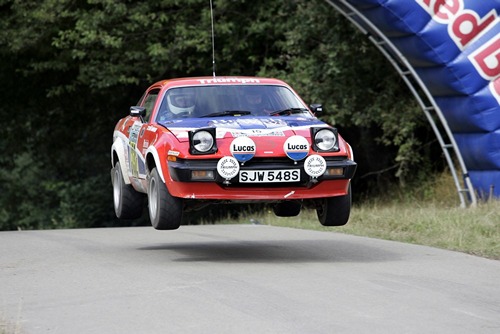It was in the late 1960s that sports cars like the Porsche 911 and Alpine Renault A110 started to make their presence felt in international rallying. The ultimate development of sports cars for rallying was the Lancia Stratos and 037 Rallye. By the 1970s, British Leyland needed a rally car to carry on from the Mini Cooper and they chose the TR7 sports car with its 2-litre, 4-cylinder, 16-valve engine. This simply was not enough and in 1977 they decided to go with the Rover V8 engined version that was being made for the American market. As the TR8 was not sold in Europe, they decided to homologate it as the TR7 V8.
With drivers like Tony Pond, Simo Lampinen and Per Eklund it achieved a few good results and proved to be exceptionally good on tarmac with pace notes. With Pond driving, it won the Ypres Rally and the Manx International twice in 1978 and 1980. On gravel roads, it was less easy to drive especially on unpractised stages. Per Eklund finished third on the 1980 1000 Lakes Rally and Tony Pond got as high as fourth on the 1978 RAC Rally but elsewhere, its short wheelbase, long bonnet and sports car driving position kept it behind the Ford Escorts. With 300 bhp from its 3,492cc V8 engine, the TR7 V8 was always popular with the spectators.
This car is a lovingly preserved and maintained example that dates from 1978 when it was built for Jean-Luc Thérier to drive in Corsica. His rally was short since some nice person crawled into parc fermé before the start and loosened the gearbox drain plug. Simo Lampinen drove it on the 1978 RAC Rally and in 1979 Per Eklund astonished everyone by using it to finish second overall on a very snowy and icy Mintex Rally. Originally, this car had two twin-choke Webers but Steve Rockingham has swapped it onto the later four- carburettor set-up.
Technical :-
Engine : eight-cylinder, 90°V, longitudinally mounted in front, single camshaft with hydraulic tappets and push rods, 295 bhp, 3,492cc
Induction : four horizontal Weber 45 DCOE carburettors
Body : unitary steel construction two-door sports coupé
Suspension front : McPherson struts with a lower track control arm and anti-roll bar.
Suspension rear : live axle with twin radius arms and a panhard rod, coil springs and telescopic dampers.
Transmission : five-speed Rover 77mm gearbox mounted behind the engine driving the rear wheels via a propeller shaft.
Weight : around 1,070 kg

